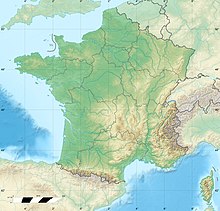Grand Antique marble: Difference between revisions
Primergrey (talk | contribs) m Primergrey moved page Grand Antique marble to Grand antique marble: Change to sentence case (MOS:AT) |
|||
| (3 intermediate revisions by 2 users not shown) | |||
| Line 5: | Line 5: | ||
}} |
}} |
||
{{Infobox cave |
{{Infobox cave |
||
| name = Grand |
| name = Grand Antique marble |
||
| photo = Aquitanian marble.jpg |
| photo = Aquitanian marble.jpg |
||
| photo_caption = also '''Celtic marble''' ({{ |
| photo_caption = also '''Celtic marble''' ({{langx|la|marmor celticum}})<br />'''Grand Antique of Aubert''' |
||
| map = France |
| map = France |
||
| relief = 1 |
| relief = 1 |
||
| Line 21: | Line 21: | ||
}} |
}} |
||
[[File:Marbre Grand Antique.jpg|thumb|upright|]] |
[[File:Marbre Grand Antique.jpg|thumb|upright|]] |
||
'''Grand |
'''Grand Antique marble''' (also '''Celtic marble''' ({{langx|la|marmor celticum}}), '''Grand Antique of Aubert''', and known in Roman times as '''''Marmor Aquitanicum'''''), is a prestigious marble, composed of [[Clastic rock|clasts]] of black [[limestone]] and white [[calcite]], quarried near [[Moulis, Ariège|Aubert-Moulis]] in France. The [[fault breccia]] from which it is extracted was formed at the end of the [[Cretaceous]] period, following the corrugation that affected the Northern Pyrenean area about 65 million years ago.{{r|Escavamar}} |
||
The marble was first quarried by the Romans in the third or fourth century and was exported in large quantities to Rome and Constantinople, primarily for decorative columns. Roman examples include the ''[[Ciborium (architecture)|ciborium]]'' in [[Santa Cecilia in Trastevere|Santa Cecilia]] and the candelabra of the [[Paschal candle]] in [[Santa Maria Maggiore]]. In Byzantium, the marble was used for decorative panels in [[Hagia Sophia]].{{r|ppmb}} |
The marble was first quarried by the Romans in the third or fourth century and was exported in large quantities to Rome and Constantinople, primarily for decorative columns. Roman examples include the ''[[Ciborium (architecture)|ciborium]]'' in [[Santa Cecilia in Trastevere|Santa Cecilia]] and the candelabra of the [[Paschal candle]] in [[Santa Maria Maggiore]]. In Byzantium, the marble was used for decorative panels in [[Hagia Sophia]].{{r|ppmb}} |
||
| Line 37: | Line 37: | ||
==References== |
==References== |
||
{{Reflist|refs= |
{{Reflist|refs= |
||
<ref name = Escavamar>{{cite web|url=https://escavamar.com/la-nostra-cava.php|title=Marmo Grand Antique|access-date= |
<ref name = Escavamar>{{cite web|url=https://escavamar.com/la-nostra-cava.php|title=Marmo Grand Antique|access-date=9 November 2021|archive-date=12 November 2021|archive-url=https://web.archive.org/web/20211112140541/https://escavamar.com/la-nostra-cava.php|url-status=dead}}</ref> |
||
<ref name = ppmb>{{cite book|title=Pensabene, Patrazio and Matthias Bruno, ''Il marmo e il colore guida fotografica: i marmi della collezione Podesti''|location=Rome|publisher= L'Erma di Bretschneider|year=1998|page=15|isbn=8870629996}}</ref> |
<ref name = ppmb>{{cite book|title=Pensabene, Patrazio and Matthias Bruno, ''Il marmo e il colore guida fotografica: i marmi della collezione Podesti''|location=Rome|publisher= L'Erma di Bretschneider|year=1998|page=15|isbn=8870629996}}</ref> |
||
}} |
}} |
||
Latest revision as of 00:36, 1 November 2024
This article has multiple issues. Please help improve it or discuss these issues on the talk page. (Learn how and when to remove these messages)
|
| Grand Antique marble | |
|---|---|
 also Celtic marble (Latin: marmor celticum) Grand Antique of Aubert | |
| Location | near Aubert-Moulis, France |
| Coordinates | 42°57′43″N 1°05′30″E / 42.96194°N 1.09167°E |

Grand Antique marble (also Celtic marble (Latin: marmor celticum), Grand Antique of Aubert, and known in Roman times as Marmor Aquitanicum), is a prestigious marble, composed of clasts of black limestone and white calcite, quarried near Aubert-Moulis in France. The fault breccia from which it is extracted was formed at the end of the Cretaceous period, following the corrugation that affected the Northern Pyrenean area about 65 million years ago.[1]
The marble was first quarried by the Romans in the third or fourth century and was exported in large quantities to Rome and Constantinople, primarily for decorative columns. Roman examples include the ciborium in Santa Cecilia and the candelabra of the Paschal candle in Santa Maria Maggiore. In Byzantium, the marble was used for decorative panels in Hagia Sophia.[2]
The quarry was subsequently closed, and the blocks already extracted were utilized for several churches, including St Peter's Basilica in Rome, St Mark's Basilica in Venice, and Westminster in London. The marble was widely used by Émile-Jacques Ruhlmann for fireplaces. Examples are also found in the Les Invalides, for the columns on the altar in the chapel and the tomb of Joseph Napoleon, and at Versailles.[1] More recently, this marble had also been extensively used in New York during the 1920s on the exterior facade of the Roosevelt Hotel, as well as on the recent extension of the Museum of Modern Art for interior decoration.[3]
Exploited intermittently and then closed in 1948, the quarry was reopened in 2012 when the Italian company Escavamar purchased the operating rights with the goal of providing high-quality marble in measured quantities to a luxury and high-end clientele. In 2015, Escavamar officially registered the trademark "Grand Antique d'Aubert".[3]
-
Altar of the Madonna Nicopeia
(St Mark's Basilica) -
Tomb of Joseph Napoleon
(Les Invalides) -
Roosevelt Hotel in New York City
References
[edit]- ^ a b "Marmo Grand Antique". Archived from the original on 12 November 2021. Retrieved 9 November 2021.
- ^ Pensabene, Patrazio and Matthias Bruno, Il marmo e il colore guida fotografica: i marmi della collezione Podesti. Rome: L'Erma di Bretschneider. 1998. p. 15. ISBN 8870629996.
- ^ a b Le marbre de luxe d'Aubert s'exporte jusqu'aux États-Unis (Aubert's luxury marble is exported all the way to the United States), Sylvie Cazalé, La Dépêche du Midi




